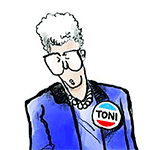Trump's plan to strip protections from federal forests affects 62,000 acres in Minnesota
Published in News & Features
MINNEAPOLIS — The Trump administration’s plan to roll back protections of “roadless areas” of federal forests would open up 62,000 acres in Superior National Forest, some of it in the Boundary Waters watershed.
The areas affected, in St. Louis, Lake, and Cook counties, are small compared to many other states like Alaska, where nearly 15 million acres could be opened up. A forest industry representative said the change isn’t likely lead to more logging and road construction in Minnesota because of the low quality of the timber.
But some scientists and environmental advocates criticized the proposed elimination of a rule first adopted in 2001, saying it will harm natural resources without accomplishing its stated goal of reducing wildfires.
Protections from logging and road construction are still intact for the Boundary Waters Canoe Area Wilderness (BWCAW), which encompasses 1.1 million acres. These safeguards were passed by Congress in 1978 and can only be repealed through the legislative process.
However, two of the largest inventoried roadless areas in Minnesota are parts of important watersheds — the BWCAW watershed and the Lake Superior watershed, said Lee Frelich, director of the University of Minnesota Center for Forest Ecology.
Watershed health is crucial to maintaining high water quality and reducing risk for invasive species colonization in the forest area, according to the Environmental Protection Agency. In explaining the rationale for the roadless rule in 2001, the U.S. Forest Service wrote that road construction and timber harvest could result in adverse effects to watersheds.
Roadless areas also enhance the value of the BWCAW as a wilderness area by acting as a buffer between the BWCAW and unprotected areas. They offer many types of habitat and provide areas for semi-wilderness recreation, Frelich said.
Trump’s rescission of the roadless rule is one move among many aimed at accelerating natural resource extraction. In March, the U.S. Forest Service committed to increasing timber harvest by 25% on national forests.
However, most types of timber found in Minnesota’s roadless areas are “not extremely valuable, since they tend to be low-productivity sites near the BWCAW, growing on rocky terrain and swamps,” said Frelich.
Timber in these areas are also largely inaccessible for companies looking to harvest in the Superior National Forest.
Roadless areas are often far from population centers and lumber mills, said Rick Horton, executive vice president of Minnesota Forest Industries, a trade association for forest products mills. “Even if they were to be put up [for logging], because they’re so remote, there’s some high likelihood that nobody would be interested in it,” he said.
Nevertheless, environmental activists view the stripping of protections as a broader assault on public lands and conservation.
“Unfortunately, we’re seeing these attacks happen throughout the country, and this is one more iteration of that, opening up these public lands to private industry to exploit,” said Pete Marshall, communications director of Friends of the Boundary Waters Wilderness.
Rescinding the roadless rule would give local agencies more flexibility to act quickly in reducing wildfire risk, USDA Secretary Brooke Rollins said Monday in announcing the rollback.
Currently, the roadless rule allows road construction in cases of an imminent threat of fire. It also allows for the cutting of “generally small diameter trees” to reduce the risk of “uncharacteristic wildfire effects” if access can be gained through existing roads.
Frelich is not convinced that allowing road construction would improve wildfire prevention or mitigation. Logging can increase the probability of fire, he said.
“The types of roads built in these areas are not big enough to serve as a firebreak if wildfires are ignited by lightning, and they give easy access to the areas for people who may accidentally start wildfires,” he said.
Frelich added that roadless areas along the BWCAW also provide a buffer against large wildfires that ignite inside the wilderness, preventing them from reaching areas with houses.
The only case in which rescinding logging restrictions would decrease the intensity of fire would be if the Forest Service logged a coniferous forest and replaced it with hardwoods such as aspen, birch or maple, Frelich said.
©2025 New York Daily News. Visit at nydailynews.com. Distributed by Tribune Content Agency, LLC.






Comments